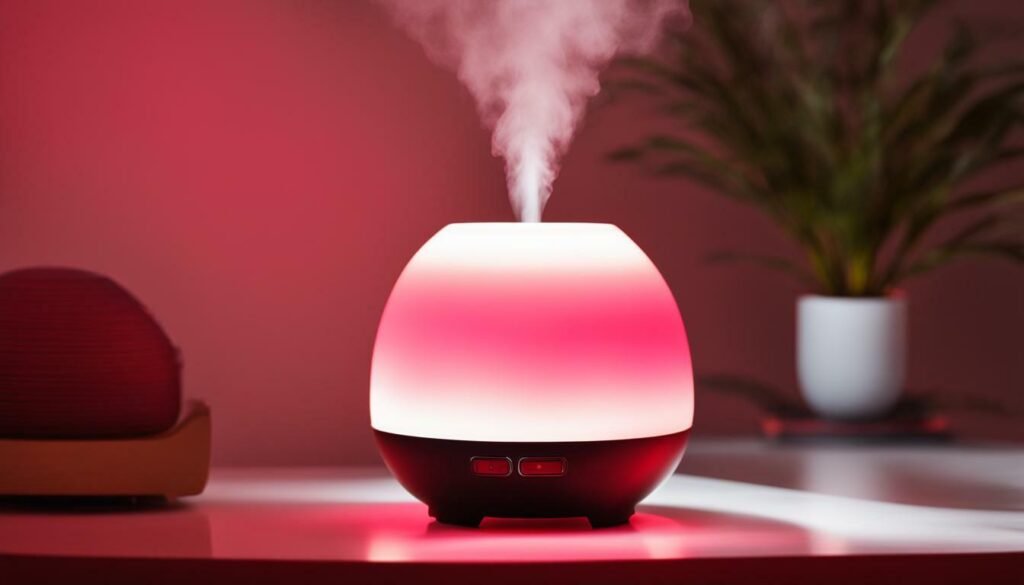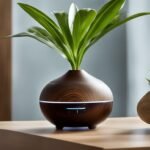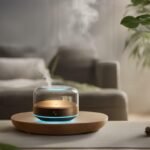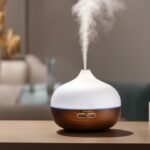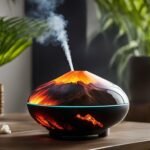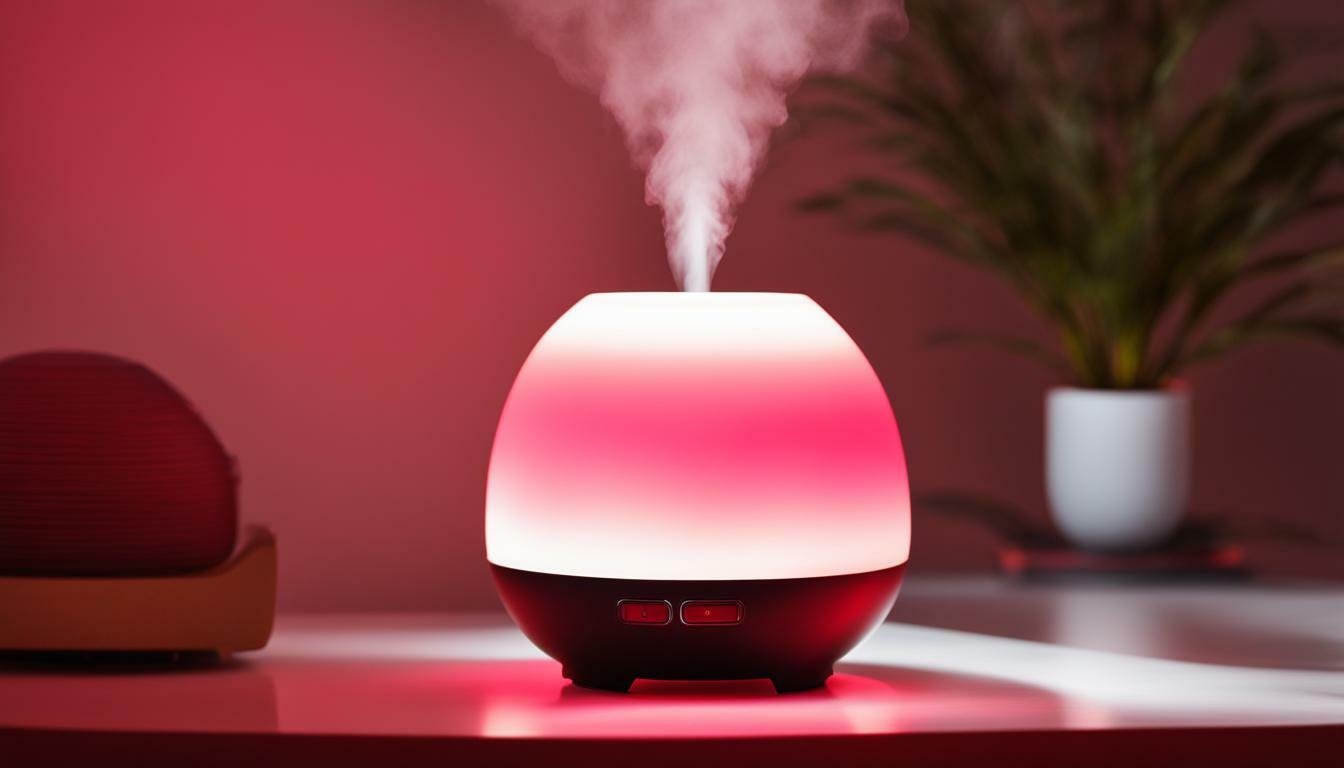
If you’re experiencing the frustrating problem of your oil diffuser constantly turning off, there are a few potential causes you should investigate. One common issue is that the diffuser gets wet or has essential oil inside, which can cause it to stop working. To fix this, unplug the diffuser, clean it, remove any water or oil, and let it dry for a day or two. Additionally, keeping your diffuser clean and using filtered, tap, or spring water can help prevent issues with diffusion. Make sure the diffuser is placed on a hard surface and the water level is not too high or too low. If the water in the diffuser is hot, either due to overfilling or normal levels, let it cool down before restarting. If the diffuser doesn’t turn on despite the light indicators flashing, check that it is on a level surface and plugged in correctly. Regular cleaning and maintenance are necessary to prevent mineral or oil buildup, which can affect the diffuser’s performance.
Moisture and Essential Oil Buildup
One common reason for an oil diffuser to keep turning off is moisture or essential oil buildup within the device, which can interfere with its functionality. When excess moisture or essential oil accumulates inside the diffuser, it can clog the internal components and cause electrical issues, leading to the device shutting off unexpectedly.
To resolve this problem, it is important to regularly clean and maintain your oil diffuser. Start by unplugging the diffuser from the power source and emptying any remaining water or essential oil. Gently wipe the interior and exterior of the diffuser with a soft cloth to remove any moisture or oil residue. If necessary, use a cotton swab dipped in rubbing alcohol to clean hard-to-reach areas.
Once the diffuser is clean, allow it to dry completely for at least a day or two before using it again. This will ensure that all moisture has evaporated and prevent further buildup. Remember to empty and clean your diffuser after each use to avoid future issues with moisture or essential oil accumulation.
| Troubleshooting Tips: Moisture and Essential Oil Buildup | Solutions |
|---|---|
| Regular cleaning | Wipe the diffuser interior and exterior with a soft cloth, using rubbing alcohol if necessary. |
| Drying time | Allow the diffuser to dry completely for at least a day or two before using it again. |
| Post-use maintenance | Empty and clean the diffuser after each use to prevent future buildup. |
By taking these simple steps, you can maintain the optimal performance of your oil diffuser. Regular cleaning and maintenance will help prevent issues caused by moisture and essential oil buildup, ensuring that your diffuser continues to function effectively and provide you with the desired aromatherapy experience.
Cleaning and Maintenance
Keeping your oil diffuser clean and well-maintained is crucial to ensuring it functions properly and doesn’t turn off unexpectedly. Over time, essential oil residue and mineral buildup can accumulate inside the diffuser, affecting its performance. Regular cleaning is essential to prevent these issues.
To clean your diffuser, start by unplugging it from the power source. Empty any remaining water and essential oils from the reservoir. Use a soft, lint-free cloth or cotton swab to wipe out the interior of the diffuser, removing any residue. Be gentle when cleaning the ultrasonic plate, as it is delicate.
For a deeper clean, mix equal parts water and vinegar and use this solution to clean the diffuser’s reservoir and ultrasonic plate. Let the solution sit for 10-15 minutes to break down any stubborn buildup, then rinse thoroughly with clean water.
In addition to regular cleaning, proper maintenance is important for the longevity of your diffuser. Follow the manufacturer’s instructions for maintenance, which may include replacing filters, cleaning the ultrasonic plate, or performing other maintenance tasks at regular intervals. By following these guidelines, you can prevent issues such as clogging, malfunctioning, or the diffuser turning off unexpectedly.
| Tip: | Use filtered, tap, or spring water when filling your diffuser. Hard water, which contains high mineral content, can contribute to mineral buildup inside the diffuser. Using distilled or filtered water can help prevent this issue. |
|---|---|
| Tip: | Place your diffuser on a stable, flat surface to ensure it operates correctly. Avoid placing it on any delicate or uneven surfaces that may cause vibration or instability. |
| Tip: | Check the water level regularly and do not overfill or let it get too low. Keeping the water level within the recommended range will help maintain optimal diffusion performance. |
Water Level and Temperature
Properly managing the water level and temperature in your oil diffuser is essential to prevent it from turning off unexpectedly. When the water level is too high, it can overflow and trigger the diffuser’s automatic shut-off mechanism. On the other hand, if the water level is too low, the diffuser may not have enough water to operate properly, leading to it turning off. Maintaining the optimal water level ensures consistent performance and prolongs the lifespan of your diffuser.
In addition to monitoring the water level, it is important to pay attention to the temperature of the water in your diffuser. If the water becomes too hot, either due to overfilling or using the diffuser for an extended period, it can cause the diffuser to automatically shut off as a safety measure. To avoid this, make sure to use filtered, tap, or spring water at room temperature. If the diffuser contains hot water, allow it to cool down before restarting to prevent any damage to the internal components of the device.
To help maintain the appropriate water level and temperature, it is recommended to refer to the user manual provided by the manufacturer. The manual usually includes specific guidelines on the maximum water capacity and suitable water temperature for your particular model of oil diffuser. Following these instructions accurately will minimize the risk of the diffuser turning off unexpectedly and ensure optimal performance.
| Water Level | Temperature |
|---|---|
| Ensure the water level is between the minimum and maximum markers indicated on the diffuser. | Use room temperature water to avoid overheating the diffuser. |
| Do not exceed the maximum water capacity to prevent overflow and automatic shut-off. | Allow hot water to cool down before using or refilling the diffuser. |
| Regularly check and adjust the water level as needed to maintain optimal diffusion. | Refer to the user manual for specific water temperature recommendations for your diffuser model. |
Checking Power and Placement
Sometimes, the problem of an oil diffuser turning off can be as simple as an incorrect power source or an inadequate placement. Before panicking, let’s check these two factors to troubleshoot the issue.
Firstly, ensure that the diffuser is properly connected to a power source. Check if the power cord is securely plugged into an outlet or if the batteries are fully charged and correctly inserted. Additionally, verify if the power switch is in the “on” position. Sometimes, a loose connection or a drained battery can cause the diffuser to shut off intermittently.
Secondly, consider the placement of the diffuser. It should be positioned on a stable and level surface to prevent any accidental disruptions. Uneven or tilted surfaces may cause the diffuser to turn off unexpectedly. Moreover, make sure that the diffuser is not placed near any heat sources or direct sunlight as excessive heat can affect its performance and potentially cause it to shut down.
As you troubleshoot these power and placement issues, remember to consult the manufacturer’s instructions for specific guidelines on power requirements and ideal placement for your oil diffuser model.
Additional Tips for Troubleshooting
If you’ve checked the power and placement and your oil diffuser is still turning off, here are a few more tips to consider:
- Inspect the power cord or battery compartment for any signs of damage or wear. If necessary, replace the cord or batteries.
- Make sure that the water level in the diffuser is within the recommended range. Too little or too much water can affect its operation.
- Consider the surrounding environment. Excessively dry or humid conditions may impact the diffuser’s performance.
| Possible Issue | Solution |
|---|---|
| Incorrect power source | Double-check the power cord or batteries and ensure they are properly connected and functioning. |
| Inadequate placement | Ensure the diffuser is on a stable and level surface, away from heat sources and direct sunlight. |
| Low or high water level | Adjust the water level to the recommended range specified by the manufacturer. |
| Dry or humid environment | Consider using a humidifier in dry conditions or a dehumidifier in excessively humid conditions to optimize the diffuser’s performance. |
Conclusion
By following the suggestions outlined in this article, you can troubleshoot and resolve the issue of your oil diffuser turning off, ensuring a seamless diffusion experience. If your oil diffuser keeps turning off, there could be several reasons for it. One common issue is that the diffuser gets wet or has essential oil inside, which can cause it to stop working.
To fix this, unplug the diffuser, clean it, remove any water or oil, and let it dry for a day or two. Additionally, keeping your diffuser clean and using filtered, tap, or spring water can help prevent issues with diffusion. Make sure the diffuser is placed on a hard surface and the water level is not too high or too low.
If the water in the diffuser is hot, either due to overfilling or normal levels, let it cool down before restarting. If the diffuser doesn’t turn on despite the light indicators flashing, check that it is on a level surface and plugged in correctly. Regular cleaning and maintenance are necessary to prevent mineral or oil buildup, which can affect the diffuser’s performance.
By taking these steps and ensuring proper care and maintenance, you can enjoy the benefits of your oil diffuser without any interruptions. Remember to always refer to the manufacturer’s instructions and guidelines for specific troubleshooting steps and solutions for your particular oil diffuser model. Happy diffusing!
FAQ
Why does my oil diffuser keep turning off?
If your oil diffuser keeps turning off, there could be several reasons for it. One common issue is that the diffuser gets wet or has essential oil inside, which can cause it to stop working. To fix this, unplug the diffuser, clean it, remove any water or oil, and let it dry for a day or two. Additionally, keeping your diffuser clean and using filtered, tap, or spring water can help prevent issues with diffusion. Make sure the diffuser is placed on a hard surface and the water level is not too high or too low. If the water in the diffuser is hot, either due to overfilling or normal levels, let it cool down before restarting. If the diffuser doesn’t turn on despite the light indicators flashing, check that it is on a level surface and plugged in correctly. Regular cleaning and maintenance are necessary to prevent mineral or oil buildup, which can affect the diffuser’s performance.
How does moisture and essential oil buildup affect my oil diffuser?
Moisture and essential oil buildup can cause your oil diffuser to stop working. When the diffuser gets wet or has essential oil inside, it can disrupt the internal components and prevent proper functioning. To resolve this issue, unplug the diffuser, clean it thoroughly, and remove any water or oil residue. Let the diffuser dry for a day or two before using it again. Regular cleaning and maintenance will help prevent moisture and essential oil buildup in the future.
How should I clean and maintain my oil diffuser?
Regular cleaning and maintenance are essential to prevent issues with an oil diffuser turning off. To clean your diffuser, follow these steps:
1. Unplug the diffuser and empty any remaining water or oil.
2. Use a soft cloth or cotton swab to wipe the interior and exterior of the diffuser.
3. For stubborn residue, mix a solution of equal parts water and vinegar and use it to clean the diffuser.
4. Rinse the diffuser thoroughly with clean water and dry it completely before using it again.
In addition to cleaning, regularly check and replace the wick, if applicable, and remove any mineral or oil buildup that may affect the diffuser’s performance.
What should be the water level and temperature in my oil diffuser?
Maintaining the proper water level and temperature is important for optimal performance of your oil diffuser. The water level should not exceed the maximum fill line indicated on the diffuser, as overfilling can lead to issues with diffusion and potentially cause the diffuser to turn off. Conversely, make sure the water level doesn’t fall below the minimum fill line to ensure consistent diffusion. As for temperature, if the water in the diffuser is hot, either due to overfilling or normal levels, let it cool down before restarting. This will prevent any potential damage to the diffuser and ensure safe operation.
What should I check if my oil diffuser doesn’t turn on despite the light indicators flashing?
If your oil diffuser doesn’t turn on despite the light indicators flashing, there are a few things you can check:
– Ensure that the diffuser is placed on a level surface, as an uneven surface can cause the diffuser to turn off automatically.
– Check that the diffuser is plugged into a working power source and that the power cord is securely connected.
– Verify that the power switch or button on the diffuser is in the “on” position.
By troubleshooting these aspects, you can often resolve the issue and get your oil diffuser to turn on correctly.
What is the importance of regular maintenance for my oil diffuser?
Regular maintenance is crucial for the proper functioning of your oil diffuser. Over time, mineral or oil buildup can accumulate and affect the diffuser’s performance, causing it to turn off unexpectedly. By regularly cleaning your diffuser, removing any residue, and ensuring that the water and essential oils used are clean, you can prevent these issues. Additionally, checking the power source, water level, and placement of the diffuser are important maintenance steps to troubleshoot any potential problems. By practicing regular maintenance, you can extend the lifespan of your oil diffuser and ensure consistent diffusion.

